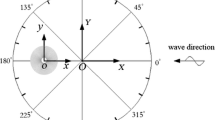Abstract
Heave plates can be employed to control undesirable heave motion amplitudes of the deepwater octagonal Floating, Drilling, Production, Storage, and Offloading (FDPSO) platform. Numerical simulations and model tests were applied to analyze and investigate the hydrodynamic response and the feasibility of the heave plate configurations. The diameter and the depth below the free surface of a single-layer heave plate, as well as the spacing of two-layer heave plates, were considered as the primary variables when studying the effect of heave plates on FDPSO hydrodynamics. The analysis results indicate that the heave plate diameter significantly affects the heave hydrodynamics, and heave performance could be improved with an increased diameter. In addition, increasing the depth below the free surface of a single-layer heave plate does not effectively suppress the heave motion within the range of draft depths tested. The target FDPSO obtained better heave characteristics with increased spacing between the two-layer heave plates. Furthermore, the global performances of the octagonal FDPSO with these typical heave plate configurations were comparatively analyzed. The results indicate that from a hydrodynamic point of view, the single-layer heave plate configuration has an advantage over the two-layer heave plate configuration.
Similar content being viewed by others
References
DNV, 1993. SESAM User’s Manual-WADAM. Det Norske Veritas.
DNV, 2005. SESAM User`s Manual-DeepC. Det Norske Veritas.
Downie MJ, Graham JMR, Hall C, Incecik A, Nygaard I, 2000. An experimental investigation of motion control devices for truss spars. Marine structures, 13(2), 75–90. DOI: https://doi.org/10.1016/S0951-8339(00)00010-1
Fan T, Qiao D, Ou J, 2014. Dynamic effects of equivalent truncated mooring systems for a semi-submersible platform. Brodogradnja, 65(4), 35–51.
Garrido-Mendoza CA, Thiagarajan KP, Souto-Iglesias A, Colagrossi A, Bouscasse B, 2015. Computation of flow features and hydrodynamic coefficients around heave plates oscillating near a seabed. Journal of Fluids and Structures, 59, 406–431. DOI: 10.1016/j.jfluidstructs.2015.10.003
Harris WD, Howard HJ, Hampshire KC, Moore JA, Bayne KJ, Pepin-LeHalleur J, 2010. FDPSOs: The new reality, and a game-changing approach to field development and early production system. Offshore Technology Conference, Houston. DOI: 10.4043/20482-MS
Haslum HA, Faltinsen OM, 1999. Alternative shape of spar platforms for use in hostile areas. Offshore Technology Conference, Houston. DOI: 10.4043/10953-MS
Lavrov A, Guedes Soares C, 2016. Modelling the heave oscillations of vertical cylinders with damping plates. International Journal of Maritime Engineering, 158, 187–197. DOI: 10.3940/rina.ijme.2016.a3.365
Lee C, Newman JN, 2005. Computation of wave effects using the panel method. Numerical Models in Fluid Structure Interaction, 42, 211–251. DOI: 10.2495/978-1-85312-837-0/06
Li J, Liu S, Zhao M, Teng B, 2013. Experimental investigation of the hydrodynamic characteristics of heave plates using forced oscillation. Ocean Engineering, 66(5), 82–91. DOI: 10.1016/j.oceaneng.2013.04.012
Li YC, Cheng L, Thiagarajan K, 1999. Numerical estimation of hydrodynamic heave damping of a vertical cylinder with appendages. The ninth International Offshore and Polar Engineering Conference, Brest, France, ISOPE-I-99-297.
Lopez-Pavon C, Souto-Iglesias A, 2015. Hydrodynamic coefficients and pressure loads on heave plates for semi-submersible floating offshore wind turbines: A comparative analysis using large scale models. Renewable Energy, 81, 864–881. DOI: 10.1016/j.renene.2015.04.003
Lu HN, Yang J, Peng T, 2006. Research on parameters of perforated wall in current generation system of deepwater offshore basin. Journal of Hydrodynamics (Ser. A), 21(2), 198–204.
Philip NT, Nallayarasu S, Bhattacharyya SK, 2013. Experimental investigation and CFD simulation of heave damping effects due to circular plates attached to spar hull. Ships and Offshore Structures, 2013, 1–17. DOI: 10.1080/17445302.2013.835146
Rho JB, Korobkin AA, Jung JJ, Shin HS, Lee WS, 2007. Coupled analysis of deepwater floating system including VIV in time domain. Proceedings of the 26th International Conference on Offshore Mechanics and Arctic Engineering, 639–649. DOI: 10.1115/OMAE2007-29523
Prislin I, Blevins RD, Halkyard JE, 1998. Viscous damping and added mass of solid square plates. 17th International Conference on Offshore Mechanics and Arctic Engineering, Lisbon, 54–75.
Shen W, Tang Y, Liu L, 2012. Research on the hydrodynamic characteristics of heave plate structure with different form edges of a spar platform. China Ocean Engineering, 26(1), 177–184.
Stansberg CT, Ormberg H, Oritsland O, 2002. Challenges in deep water experiments: hybrid approach. Journal of Offshore Mechanics and Arctic Engineering, 124(2), 90–96. DOI: 10.1115/1.1464129
Su Y, Yang J, Xiao L, 2009. Hybrid verification of a deepwater cell-truss spar. China Ocean Engineering, 23(1), 1–14.
Tao L, Cai S, 2004. Heave motion suppression of a Spar with a heave plate. Ocean Engineering, 31(5), 669–692. DOI: 10.1016/j.oceaneng.2003.05.005
Tao L, Dray D, 2008. Hydrodynamic performance of solid and porous heave plates. Ocean Engineering, 35(10), 1006–1014. DOI: 10.1016/j.oceaneng.2008.03.003
Tao L, Lim KY, Thiagarajan K, 2004. Heave response of classic spar with variable geometry. Journal of Offshore Mechanics and Arctic Engineering, 126(1), 90–95.
Tao L, Molin B, Scolan YM, Thiagarajan, K, 2007. Spacing effects on hydrodynamics of heave plates on offshore structures. Journal of fluids and structures, 23(8), 1119–1136. DOI: 10.1016/j.jfluidstructs.2007.03.004
Tao L, Thiagarajan K, 2003a. Low KC flow regimes of oscillating sharp edges I. Vortex shedding observation. Applied Ocean Research, 25(1), 21–35. DOI: 10.1016/S0141-1187(03)00031-2
Tao L, Thiagarajan K, 2003b. Low KC flow regimes of oscillating sharp edges. II. Hydrodynamic forces. Applied Ocean Research, 25(2), 53–62. DOI: 10.1016/S0141-1187(03)00046-4
Thiagarajan KP, Datta I, Ran AZ, Tao L, Halkyard JE, 2002. Influence of heave plate geometry on the heave response of classic spars. 21st International Conference on Offshore Mechanics and Arctic Engineering, Oslo, 621–627. DOI: 10.1115/OMAE2002-28350
Ward G, Hansen VL, Kim MH, Wang L, 2004. Model-the-model: validating analysis models for deepwater structures with model tests. Offshore Technology Conference, Houston, 1144–1152. DOI: 10.4043/16586-MS
Zhang F, Yang JM, Li RP, Hu ZQ, 2006. Effects of heave plate on the hydrodynamic behaviors of cell spar platform. American Society of Mechanical Engineers, Hamburg, OMAE2006-92199: 203–209. DOI: 10.1115/OMAE2006-92199
Author information
Authors and Affiliations
Corresponding author
Additional information
Foundation item: Supported by the National Scientific and Technology Major Project under Grant No. 2016ZX05028
Rights and permissions
About this article
Cite this article
Yu, C., Hu, Z. & Wang, S. Investigation of heave response of the deepwater octagonal FDPSO using various heave plate configurations. J. Marine. Sci. Appl. 16, 446–457 (2017). https://doi.org/10.1007/s11804-017-1431-9
Received:
Accepted:
Published:
Issue Date:
DOI: https://doi.org/10.1007/s11804-017-1431-9




